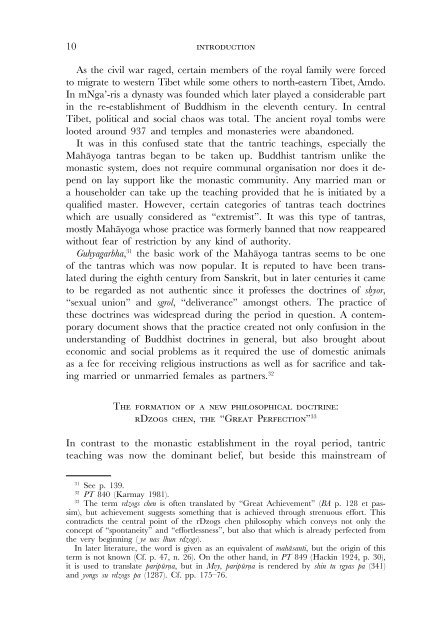You also want an ePaper? Increase the reach of your titles
YUMPU automatically turns print PDFs into web optimized ePapers that Google loves.
10 introduction<br />
As the civil war raged, certain members of the royal family were forced<br />
to migrate to western Tibet while some others to north-eastern Tibet, Amdo.<br />
In mNga’-ris a dynasty was founded which later played a considerable part<br />
in the re-establishment of Buddhism in the eleventh century. In central<br />
Tibet, political and social chaos was total. The ancient royal tombs were<br />
looted around 937 and temples and monasteries were abandoned.<br />
It was in this confused state that the tantric teachings, especially the<br />
Mahàyoga tantras began to be taken up. Buddhist tantrism unlike the<br />
monastic system, does not require communal organisation nor does it depend<br />
on lay support like the monastic community. Any married man or<br />
a householder can take up the teaching provided that he is initiated by a<br />
qualified master. However, certain categories of tantras teach doctrines<br />
which are usually considered as “extremist”. It was this type of tantras,<br />
mostly Mahàyoga whose practice was formerly banned that now reappeared<br />
without fear of restriction by any kind of authority.<br />
Guhyagarbha, 31 the basic work of the Mahàyoga tantras seems to be one<br />
of the tantras which was now popular. It is reputed to have been translated<br />
during the eighth century from Sanskrit, but in later centuries it came<br />
to be regarded as not authentic since it professes the doctrines of sbyor,<br />
“sexual union” and sgrol, “deliverance” amongst others. The practice of<br />
these doctrines was widespread during the period in question. A contemporary<br />
document shows that the practice created not only confusion in the<br />
understanding of Buddhist doctrines in general, but also brought about<br />
economic and social problems as it required the use of domestic animals<br />
as a fee for receiving religious instructions as well as for sacrifice and taking<br />
married or unmarried females as partners. 32<br />
The formation of a new philosophical doctrine:<br />
rDzogs chen, the “<strong>Great</strong> <strong>Perfection</strong>” 33<br />
In contrast to the monastic establishment in the royal period, tantric<br />
teaching was now the dominant belief, but beside this mainstream of<br />
31 See p. 139.<br />
32 PT 840 (Karmay 1981).<br />
33 The term rdzogs chen is often translated by “<strong>Great</strong> Achievement” (BA p. 128 et passim),<br />
but achievement suggests something that is achieved through strenuous effort. This<br />
contradicts the central point of the rDzogs chen philosophy which conveys not only the<br />
concept of “spontaneity” and “effortlessness”, but also that which is already perfected from<br />
the very beginning ( ye nas lhun rdzogs).<br />
In later literature, the word is given as an equivalent of mahàsanti, but the origin of this<br />
term is not known (Cf. p. 47, n. 26). On the other hand, in PT 849 (Hackin 1924, p. 30),<br />
it is used to translate paripùr»a, but in Mvy, paripùr»a is rendered by shin tu rgyas pa (341)<br />
and yongs su rdzogs pa (1287). Cf. pp. 175–76.

















